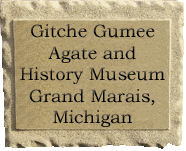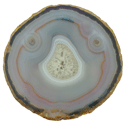MINERAL OF THE MONTH
July 2017 - Kona Dolomite
This rock is named after the Kona Hills, located in Marquette County, Michigan. This is an ancient formation of fossil stromatolite that is between 2.1 and 2.8 billion years old. Most dolomite found throughout the world is gray or white. Kona dolomite is quite colorful and is found nowhere else. Dolomite is a calcium-magnesium carbonate and fizzes in warm acid. Dolomite is limestone with magnesium added. The Kona formation is dominantly dolomite with interstratified layers of shale, graywacke and quartzite. The dolomite beds are from a few inches to many feet thick, but even the purest beds contain thin cherty layers and other sedimentary clastic material.

The original organisms that created this fossil rock were some of the first life on earth. There was nothing to eat so these early cyanobacteria survived by using the energy of the sun via photosynthesis. Cyanobacteria were responsible for producing the first oxygen on earth as a byproduct of this photosynthetic process. Thus, if it were not for stramatolitic organisms, according to scientists, we would probably not be here.
The cyanobacteria grew in shallow water as flat mats to maximize exposure to the sun. The fossil rock formed as the cyanobacteria mats trapped, bound and, and cemented sedimentary grains. Over time, as the trapped sediments blocked the energy of the sun, the cyanobacteria would develop another mat on top of the mound. The mounds grow in various shapes including conical, stratiform layers, branching, and domal.
The earliest stromatolite mounds are believed to be 3.7 billion years old. They peaked around 1.25 billion years ago. Originally scientists believed these species of cyanobacteria were extinct, until live stromatolite mounds were discovered in Sharks Bay, Australia in 1958. Even though 99 percent of all species that have ever existed on earth are extinct – it is amazing that stromatolitic organisms were the first living things on earth – and they are still here. Living stromatolites mounds can be found in Australia, Chili, Brazil, Mexico, Belize, British Columbia and the Yukon (Canada), Minnesota (US), South Africa, and the Bahamas. In modern microbial mats, debris from the surrounding habitat can become trapped within the mucus, which can be cemented together by the calcium carbonate to grow thin laminations of limestone.
Fossilized stromatolite rock can be found throughout the world. Kona dolomite is one example. Because of its tremendously old age, and due to trace minerals, Kona dolomite can be found in a variety of colors including pink, brown, yellow, tan, cream, red, and orange. The colors are often complex with mottling, banding and lacing. The black wavy lines in Kona are the remains of the microbial mats. The unique pink and red pigments are caused by the iron in the soil.
In the rough before polishing the rock does not look nearly as nice – but still cool.
Lapidary enthusiasts enjoy working with this rock because they make beautiful slabs used in crafting clocks, wind chimes, spheres, bookends, cabochons, and other items. Kona is also used for building stones and for making refractory bricks for furnace linings. Due to its vivid coloration it is also used for decorative purposes as crushed stone for borders and walkways.
CITES
- http://www.michigan.gov/documents/deq/GIMDL-PU21B_216237_7.pdf
- Mathew Parker, https://commons.wikimedia.org/wiki/File:Tolypothrix_(Cyanobacteria).JPG
- Vincent Pointer, https://commons.wikimedia.org/wiki/File:20130118-HighbormeCay-Stromatolite-03.JPG
NOTE
- Thanks to Bob and Peg Clark for their donations of Kona dolomite specimens and slabs to the Gitche Gumee Museum.
Mineral of the Month Archives
May 2007: Rainbow Fluorite
June 2007: Lake Superior Michipicoten Agate
July 2007: Labadorite
August 2007: Rain Flower Agate
Fall 2007: Malachite
December 2007: Nepheline Syenite
January 2008: Native Copper
February 2008: Amazonite
March 2008: Lake Superior Agate
April 2008: Shadow Agate
May 2008: Apohpylite
June 2008: Ocean Jasper
Summer 2008: Marra Mamba Tiger's Eye
September 2008: Mohawkite
October 2008: Mexican opal
November 2008: Prehnite
December 2008: Picture Jasper
January 2009: Sea Shell Jasper
February 2009: Polychrome Jasper
March 2009: Selenite Desert Rose
Spring 2009: Coyamito Agate
July 2009: Obsidian Needles
August 2009: Goethite
September 2009: Banded Iron Formation
Fall 2009: Fairburn Agate
March 2010: Fossilized Dinosaur Bone
April/May: 2010 Kentucky Agate
June 2010: Nantan Meteorite
July 2010: Mookaite Jasper
Aug/Sept 2010: Polyhedroid Agate
Fall 2010: Ammonite Fossil
September 2011: Petoskey Stones
Spring 2011: Petrfied Wood
Winter 2011: Argentina Condor Agate
January 2012: Mary Ellen Jasper
March 2012: Mexican Crazy Lace Agate
June 2012: Moqui Marbles
September 2012: Chlorastrolite Greenstone
March 2013: Jacobsville Sandstone
August 2013: Unakite
November 2013: Skip-an-Atom Agate
April 2014: Tiger's Eye
September 2014: Black Corundum
February 2015: Condor Agate
June 2015: Petoskey Stone
November 2015: Slag
June 2016: Lake Superior Copper Replacement Agates
March 2017: Chert
July 2017: Kona Dolomite
December 2017: Septarian Nodule
Copyright All rights reserved.
Gitche Gumee Museum.
E21739 Brazel Street
Grand Marais, Michigan 49839











